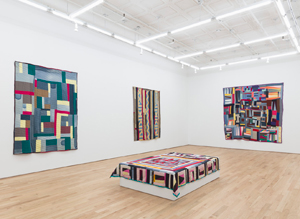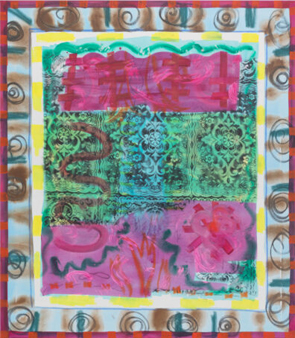She Made Her Bed
John Haberin New York City
Mary Lee Bendolph, Gee's Bend, and Christopher Stout
Margot, Agatha Wojciechowsky, and Tamara Gonzales
How have the makers of tapestry and quilting become a commonplace in galleries devoted to art? It has to do with their closeness to domestic labor, but also their aspirations to more. It has to do with who they are.
It has also become all but a cliché, along with ceramics as fine art, but that is only now. Mary Lee Bendolph has been at it for years, in what is already the third generation of Gee's Bend quilters, and she still shows how it is done. It can hardly be bedding, with so unruly a pattern, but it can hardly be anything else. Christopher Stout, in turn, claims oil on canvas for quilting—and for his identity as a gay artist.  Margot, Agatha Wojciechowsky, and Tamara Gonzales reach to outsider art, too, but for beauty, horror, and the spirit world. Can their claims be reconciled?
Margot, Agatha Wojciechowsky, and Tamara Gonzales reach to outsider art, too, but for beauty, horror, and the spirit world. Can their claims be reconciled?
Weaving as painting . . .
With all the attention to weaving as painting and all the revival of craft as art, it is easy to forget something: a quilt is for sleeping. At least it is in my home, comforting in its warmth and familiarity. I would not be too sure, though, when it comes to Mary Lee Bendolph. One work spreads out on what could pass for a bed, but a dozen more hang on the walls, enveloping the viewer more than an ordinary painting or bedspread ever could. Even that one, at the very center of her exhibition, could keep anyone awake at night.
It lies on a hard surface, way firmer than a mattress and more rigid in its geometry, but that is nothing compared to its patterns. Their loud colors cry out for attention, and neither they nor you will rest easy. Bendolph has made her bed, but she is not content to lie in it. Born in 1935, she has been doing no less for a long time now, and the Gee's Bend quilters, named for their home town in Alabama, have been at it longer still. After three generations, they have been celebrated as outsider art and as inspiration to such insiders as Michelle Obama and Amy Sherald, who drew on them for the Obama state portraits. It is rare, though, to see any one member in depth, as representative and as an individual.
Like others in Gee's Bend, Bendolph sticks to geometry. No cheery flora, fauna, or mystic symbols in these quilts—and nothing at all like the political art of Dawn Williams Boyd. She assembles them rectangle by rectangle, like a bricklayer—a word that the movement has adopted for its patterns. (Speak of a hard bed.) Like others, too, she assembles it from whatever comes to hand, in used quilts and used clothing, with one work called Corduroy. It is craft as art and as necessity.
She has not, though, run into a brick wall. Her patterns are constantly shifting. The zigs and zags in vertical bars may rise progressively from left to right—or arbitrarily in horizontals with otherwise vertical symmetry. Just as often, they run wild, reveling in imperfect repetition. In the work just off the floor, one wild pattern nests within another, as A Quilt in a Quilt, and then the frames start all over again as the quilt hangs down over the platform's edges. They become mind games as well as visual ones.
The sheer excess makes Gee's Bend newly relevant today, quite as much as gender and color. That quilt on a hard bed is not so far after all from "story quilts" by Faith Ringgold or clothing for Karyn Olivier overflowing a hard wall. Bendolph's age and geometry may also suggest Minimalism, for all her evolution apart. As with Minimalism, too, a shifting geometry brings out the work's material reality. Still, for Gee's Bend that means the texture and materials of household good and humble crafts. It also means keeping things in motion.
The show's title, "Piece of Mind" points sincerely to the piecemeal comforts of quilting—and, ironically, to the peace of mind that a hard bed and harsh colors can never bring. It points, too, to women unafraid to give you a piece of their mind. It allows for Bendolph's impulsiveness, to the point that seemingly anything goes. You may, at times, lose patience. Still, she is not so much sloppy or overly assertive as following her process and materials wherever they lead. She is just as determined not to leave anything behind.
. . . And painting as a quilt
Quilting, then, has become respectable. It has become art. Most often, that means a growing recognition of craft and design—and a refusal to set them apart. It means recognizing painting itself as craft. More and more, too, artists like Samuel Levi Jones, Katarina Riesing, Yvonne Wells, and Altoon Sultan are using patchwork fabric or a needle and thread to make painting without the paint, as, boldly, does Julia Bland again now. Christopher Stout, though, does the opposite—conceiving, he says, a painting itself as a quilt.
It is not at all obvious. Stout's gallery runs to group shows of abstract art, often dark and with heavily worked surfaces, and so does he. His quilting series is painting at its sternest and most rigorous, in black monochrome. He works in oil, like Ad Reinhardt, and enamel, like Frank Stella before sculpture. Like Stella's black paintings, too, these favor metallic paint for its glow in the dark. While he paints in copper and navy blue along with midnight black, he does not like Reinhardt ask to see colors emerge from within the black.
He works on the materials of painting, too—linen and cotton, rather than used clothes and the thicker fabric of a quilt. Rather, he gets his thickness from a painting's support. Where Stella turned the wood of a stretcher on its side to carry a painting off the wall, Stout builds his support from stacked panels. He assembles a painting from several pieces of fabric, much like quilting. Still, one could mistake them for stretched around separate panels. The dark paint continues on the sides.
Why then call it anything but painting, and does it matter? Like quilting, these are assemblages of several pieces, each a fabric in its own right. He does not intend a reference to the AIDS quilt, he says, and it would be a black future for AIDS sufferers if he did. Yet he is well aware of the association of craft and quilting with art on the margins. Others, like like American Abstract Artists, have asked about the possibilities of women in abstract art and black abstraction. Stout calls for recognition of a specifically gay abstraction.
Does it ring true? Blacks have faced absence and exclusion from the mainstream and, like Norman Lewis or Thornton Dial, gradual rediscovery. Women have faced demands to subordinate their careers to men, like Lee Krasner compared to Jackson Pollock. The week of the show's opening, Joan Snyder in The New York Times recalled how men in abstraction expression pressured women to keep up with their pace of sex and drinking, the story in a nutshell of Krasner and Pollock. Gays like Robert Rauschenberg have shined all along, alone and in collaboration. With a Johns retrospective coming, there is no forgetting Jasper Johns as the greatest living artist.
The real challenge has been to bring to the mainstream gay life, gay issues, and gay identity. For all its ingenuity, the play between painting and quilting does not of itself make Stout an obviously political artist. There may well be more powerful monochrome abstraction out there as well. Still, do not count him out. He creates texture and nuance within a single work not by variation in brushwork, but rather from his fabric's gaps and wrinkles. That casts its own light on gender, painting, and quilting.
Spirits on Lex
In the heyday of Postmodernism, art was determined be more sophisticated than, well, you. Nothing less could test your assumptions about politics and yourself. Just as challenging and frustrating, art now can seemingly be whatever springs to mind. So it is with the outpouring of images in painting, and so it is with the French artist who calls herself simply Margot. "I do not need to think about what I am doing or how I am going to do it," she says. "It is." 
Whatever it is, it is for her a spiritual connection, in what a show calls her "Cosmic Sanctuary." Margot accords with a fashion for self-taught artists—and one bonus from the shift in sensibility is that art no longer requires a Yale MFA. Yet it might be better to say that her teachers are spirits of the deep past. Her images, like those of Louise Despont, have the warm tones, obsessive line, and symmetry of mandalas. They also run to faces that she may never have seen. For some, she takes antique portrait photos as her starting point, and you may have trouble believing that they are not faces that you yourself ought to know.
Margot shares the gallery and the spirit world with Agatha Wojciechowsky, who styled herself a medium, a minister, and a healer. A poignant photograph shows a handful of her drawings on a table with a lamp bearing light from within or the great beyond. An immigrant from Germany, she could see faces from her window, but not on Lexington Avenue. Rather, they came to her as she looked onto a blank wall. They flit across a deeply colored surface as silvery ghosts. They cluster tightly in pastel colors in what could almost be thought balloons.
Could the artists have been in touch with one another, too? In reality (such as it is), Wojciechowsky died at age ninety in 1986, when Margot was no more than four. That may come as a surprise—and not just because of Margot's obsession with the past. Wojciechowsky's faces could pass for passers-by on Lex today. The curator, Aurélie Bernard Wortsman, calls the show "Spirits Among Us"—and that "us" includes you. It also includes the sophisticated face of Modernism, and the artist exhibited in her lifetime with Romare Bearden, Jean Dubuffet, Marcel Duchamp, Isamu Noguchi, Francis Picabia, and Man Ray.
Outsider art is a slippery concept—and self-taught art a capacious one. No wonder it appealed to Dubuffet and Art Brut then, and it is more slippery still today. That has been a theme of mine since my first visit to the Outsider Art Fair in search of Janet Sobel. Another European immigrant, Sobel made the first drip painting, before Jackson Pollock. And folk art can still influence younger artists like Margot. Take Tamara Gonzales, at a gallery not at all associated with the movement.
In her abstract drawings, graphite and washes have the borders and abstract patterns of Gee's Bend quilting—but then Wojciechowsky later veered on abstraction, too. In smaller drawings from Gonzales, figures and faces multiply much as for Wojciechowsky as well, but are they friendly spirits? They can be human or animal, and at least one is a skull. A glass case contains the feathers of what looks like a dead turkey, but with a woman's waist. Outsider art has always verged on madness, as with Eugen Gabritschevsky, but there is method in this madness. In a show called "Horrible Beauty," beauty and horror get along just fine.

Mary Lee Bendolph ran at Nicelle Beauchene through September 25, 2021, Christopher Stout at Lichtundfire through October 2, Julia Bland at Derek Eller through October 9, Margot Agatha Wojciechowsky at Andrew Edlin through October 23, and Tamara Gonzales at Klaus von Nichtssagend through October 23.




